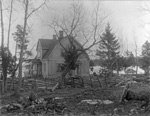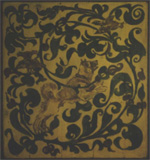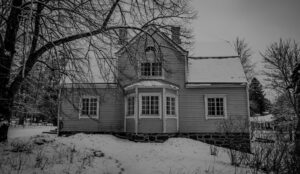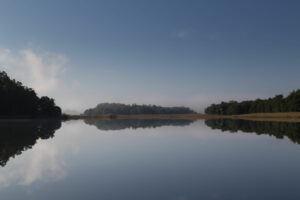Sigrid Maria Granfelt (1868–1942) bought Husö farm in 1910. At that time, the farm did not include the house that we today call the Yellow house. Sigrid designed the house herself and had it built. The Yellow house was completed in 1912. In 1940, Sigrid donated her farm including the buildings, land and water areas to the Åbo Akademi University Foundation.
Early history of Husö
Sigrid Maria Granfelt was born in 1868 in Turku and died in Helsinki in 1942, at the age of 74. For about 29 years she lived at Husö. She was an artist, who first studied at the School of Arts in Helsinki, later she studied abroad in Germany, Holland, Italy and France. She mainly painted animal motifs and portraits. After Sigrid moved to Åland, she spent less time painting. Maintaining the farm required a lot of work. On the farm, Sigrid was engaged in animal husbandry, plant cultivation, horticulture, she built and decorated furniture and even built a boat and a sleigh. Sigrid spent a lot of time developing handicrafts on Åland and she was active in the Martha movement. She was also interested in ceramics and gave courses on this subject. Sigrid had an interest in nature, which can be seen in interior details in the Yellow house and in floral motifs on the folk costumes of several of the Åland municipalities.

Sigrid’s wish was that Husö would be preserved as a nature-protected annex. Which today can be said it is, as the land and water areas belong to the Natura 2000 network. Sigrid also wanted that Husö would function as support for the botanical department that at the time was planned in Åbo Akademi University. In the end, the plans for a botanical department were canceled. However, a department in biology was founded instead in 1957.Since 1959, Husö has functioned as a field station for the Department of Environmental and Marine Biology at Åbo Akademi University. This is largely since the professor of that time, Bo-Jungar Wikgren, pointed out the need for a biological field station.

1960-70s
Already early in the history as a biological station, an agreement of collaboration was initiated with the Provincial Government of Åland. The collaboration agreement was signed in 1961 and is still in progress to this day. The agreement has meant that academic research has been conducted on Husö in parallel with applied research. The collaboration agreement itself was unique in Finland when it was signed in 1961.
During the station’s first decade, the studies were characterized by fishery biology. There were also studies that concerned macrophytes in lakes and coastal waters. During the 1970s, the importance of studies on fisheries biology diminished as several projects were transferred to the fisheries agency at the Provincial Government of Åland. The research on Husö were thus shifted more towards environmental research. Important research topics included surveys on drinking water lakes in the vicinity of water treatment plants on Åland and the effects of road banks, sand suction, dredging and tidal waves in the archipelago. A number of basic studies (aquatic chemistry, plankton, plants, benthic fauna, crayfish, birds) in the Åland lakes and coastal areas were also carried out at this time. Some of the ongoing monitoring studies began in the 1970s.

1980-90s
During the 1980s, together with the of the Provincial Government of Åland, surveys on drinking water lakes and monitoring projects of the environmental impacts of fish farms were carried out. Studies on monitoring water treatment plants’ emissions and their effects on recipient areas was also a topic of study during this time. Recovery in archipelago ecosystems after human intervention (e.g. sand suction and dredging) were also issues that were subject for studies during the 1980s. In addition, there were studies on parasites and diseases in fish, coastal lake’s production biology, algal symbiosis, bladder wrack and its growth, as well as fish stocks in shallow bays.
The experimental research and interaction between trophy levels gained more importance during the latter half of the 1980s, this continued in the 1990s. Experiments were performed both under more controlled conditions in aquariums and in the field. Many research projects incorporated aspects of the presence of toxic algae and their impact on other organisms.
In 1991, a new laboratory building was completed, replacing the old laboratory building from 1979, which greatly enhanced the research and analysis capacity. Research during the 1990s was characterized by the problems connected to eutrophication and the effects in the archipelago. During the 1990s, both applied and basic research was conducted on Husö, where, among other things, the effects of algae, oxygen deficiency and turbidity on benthic fauna and fish, was studied. Research on the presence and effects of toxic algae continued. During the 1990s, environmental monitoring studies in both lakes and coastal waters became an important part of Husö’s research profile, something that still applies today in the 2020s.

2000s
During the early 2000s, research continued in the same directions as in the late 1990s. The research focused on eutrophication and its effects, especially in coastal waters and shallow bays. At the same time, environmental monitoring became increasingly important, especially after the EU Water Framework Directive came into force. The station’s buildings were also modernized during the 2000s and new spaces were built for accommodation. This significantly increased the station’s capacity in terms of accommodating researchers and students.
